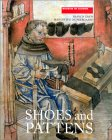Shoes and Boots
Medieval Footwear
As many of you know I’m a big fan of authentic footwear. I currently have 6 different pairs to go with different status outfits and a couple more pairs on the way. The following is not meant to be a definitive guide on footwear, just the observations and collection of an enthusiast.
Change in fashions
Medieval shoes seem to keep the same shape and styles throughout the majority of the 15th Century, which has closely resembled many of the 14th century fashions. As with all fashion in the medieval world, changes tend to be slow, before the 1460’s when the renaissance on the continent help speed up the fashion changes within England. Pre 1480’sThe upper classes these tend wear poulaines (long pointy shoes) which come in a wide variety of colours and these require a particular method of walking – you need to point your toes when walking, they are not suitable for many activities apart, which is presumably why the rich wore them (to show they were above such things). Lower class people needed to wear something more practical, poulaines would just not cut it in the fields! Ankle boots are very common (when seen) in lower working peoples pictures. These are very practical. These ankleboots are often side or front fastening, using ties, buckles or buttons. They tend to be shown in basic brown or black. Post 1480’sHowever, a new style becomes fashionable for the upper class on the on the continent around 1460 and can be seen in England by the end of 1480's with the arrival of the Tudors dynasty. These shoes are square toed and can be seen in many of the English portraits from 1485 onwards. The squared toed shoes can be found on the continent, (especially the Swiss and Italians) amongst even the lower classes by the 1485. The fashion for squared toed shoes continues from Henry VII rule through to the early Elizabethan period, with various changes in slashing and cut-outs. For the middle and lower classes I would recommend that the shoe styles would be changing by 1500, as it always takes about a decade for the fashion changes to filter through, although I would think this would mainly apply to those wearing shoes as those wearing boots may not be affected. (I have not seen any squared toed boots from this period yet – but that does not mean that they do not exist) Colour recommendations: I’m a fan of multi coloured shoes as were the medieval people judging by the portraits, but that is not altogether practical if you are starting out. Authentic medieval dyes are not necessarily fixed and can leech out, or change colour when wet. I would recommend for your first pair of shoes to be either brown or black. This is just more versatile. I would also recommend low ankle boots for women and men. How I use my shoes: Pre 1485
For my lower status working woman/ camp woman over gown and kirtle I wear a pair of ankle boots, this is just for several reasons, firstly sheer practicality – muddy fields, wet kirtles and they are hard wearing For my middle status gown – trades woman with aspirations I have some slightly pointed red ladies shoes, again these are hard wearing and practical but show a little class. For my upper status I have green cut out poulaines and plain black poulaines, which I have matching outfits for. These shoes are not at all practical and have thin soles so are best used on either dry grass or inside castles/ cobbles. Post 1485
 This is the book to learn more about shoes and pattens from, it is excellent.
This is the book to learn more about shoes and pattens from, it is excellent.
For my lower status working woman/ camp woman over gown and kirtle I wear a pair of ankle boots, this is just for several reasons, firstly sheer practicality – muddy fields, wet kirtles and they are hard wearing For my middle status gown – trades woman with aspirations I have some slightly pointed red ladies shoes, again these are hard wearing and practical but show a little class. For my upper status I have green cut out poulaines and plain black poulaines, which I have matching outfits for. These shoes are not at all practical and have thin soles so are best used on either dry grass or inside castles/ cobbles. Post 1485
I have a pair of blue square toed (with slashing) shoes. Now this is wear I have compromised due to the price and the frequency of how often I wear them. I have one pair of shoes that I wear for higher and middle status, post 1485. I then have a lower crossover pair, squarish/slightly pointed brown shoes that I wear for lower status events.
 This is the book to learn more about shoes and pattens from, it is excellent.
This is the book to learn more about shoes and pattens from, it is excellent.
Tudor Shoes
